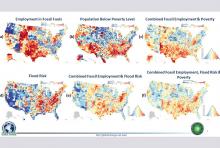Computer simulations are suggesting that as global temperatures rise, clouds become scarce, potentially causing warming to spiral out of control, reports Natalie Wolchover for WIRED. The findings published " in the journal Nature Geoscience make the case that the effects of cloud loss are dramatic enough to explain ancient warming episodes like the [Paleocene-Eocene Thermal Maximum] PETM—and to precipitate future disaster." Caltech climate researchers simulated stratocumulus clouds, which are the low-lying, and have the largest cooling effect on the planet. The researchers found a point at which the clouds break up and disappear when the amount of carbon dioxide in the model's atmosphere reaches 1,200 parts per million. This scenerio is possible in about a century under “business-as-usual” emissions. After this point, the model reports that Earth's temperature rises 8 oC on top of the 4 oC, which the carbon dioxide directly caused.
Once clouds go away, the simulated climate “goes over a cliff,” said Kerry Emanuel, a climate scientist at the Massachusetts Institute of Technology. A leading authority on atmospheric physics, Emanuel called the new findings “very plausible,” though, as he noted, scientists must now make an effort to independently replicate the work.
Story Image: A state-of-the-art supercomputer simulation indicates that a feedback loop between global warming and cloud loss can push Earth’s climate past a disastrous tipping point in as little as a century. (Image: Michelle Yun/Quanta Magazine, iStock)
Link to article:



